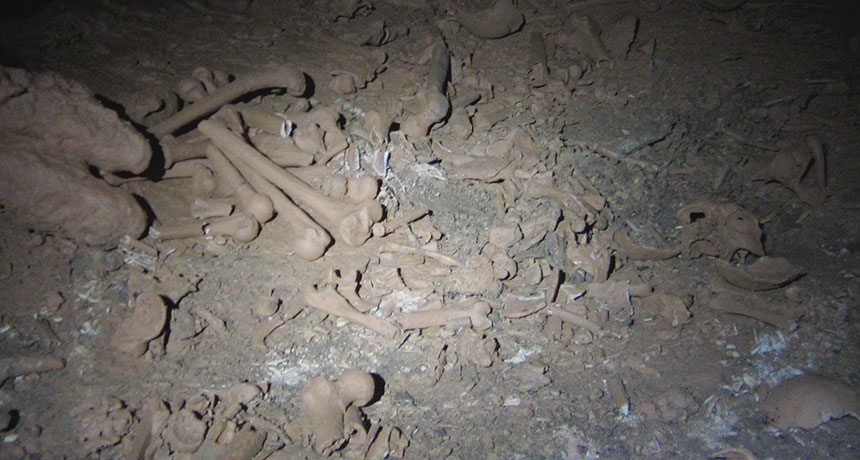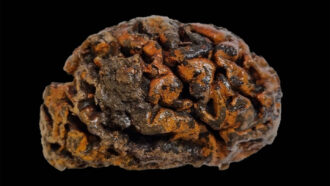Remains of long-ago child sacrifices found in Belize cave
Midnight Terror Cave lived up to its name

These bones were found in Belize’s Midnight Terror Cave. They indicate that the ancient Maya did not just sacrifice adults. The bodies had been placed throughout a roughly 1,500-year span in what was considered a sacred space. But this practice ended hundreds of years ago.
BRUCE MINKIN
By Bruce Bower
ATLANTA, Ga. — Midnight Terror Cave has a name that really fits. Grim discoveries there are shedding light on a long tradition of child sacrifices. They happened long, long ago.
Researchers have often emphasized that human sacrifices in ancient Central American and Mexican civilizations targeted adults. Clearly, however, not all were adults. In fact, these rituals occurred so long ago that no one today can be sure how or why someone would have been chosen.
From 2008 to 2010, scientists found 9,566 human bones, bone fragments and teeth on the floor of the cave in Belize. (Belize is a country in Central America.) A large share of those pieces, it now turns out, had belonged to individuals no more than 14 years old, reports Michael Prout. He is an archaeologist at California State University, Los Angeles. Many of the bones came from 4- to 10-year-olds. But because the bones are so broken, it’s hard to estimate precisely how many people they represent.
The bones belonged to a people called the Maya. They had a grand civilization in Mexico and Central America. It spanned from about 2500 B.C. to 1500 A.D. Their descendants still live in the region today.
Prout and his colleagues suspect the children were sacrificed to a god that the ancient Maya called Chaac. Those ancient people might have believed that pleasing this god would bring them rain, water and lightning. Prout described his team’s findings April 15 at the annual meeting, here, of the American Association of Physical Anthropologists.
The researchers used radiocarbon dating to determine how long the bones had been sitting in the cave. The technique works by comparing the relative share of two forms of carbon — carbon-12 and carbon-14. The ratio changes as the radioactive form (carbon-14) decays and is not replaced.
That dating method indicates the Maya deposited one or a few bodies at a time in the cave. This took place over a roughly 1,500-year span, Prout says. It started at the dawn of Maya civilization, some 3,000 years ago. At least 114 bodies were dropped in the deepest, darkest part of the cave, near an underground stream. The remains from more than half of those bodies came from people 14 or younger. The ancient Maya considered inner cave sites with water sources to be sacred. This suggests the bodies were intentionally placed there as offerings to Chaac.
The researchers found no evidence that the cave remains came from people who had died of natural causes or who had been buried.
This is not the first evidence of child sacrifice in the ancient past. Chichén Itzá is an ancient Maya city in southern Mexico. An underground cave there also hosted evidence from long, long ago of large-scale Maya child sacrifices, Prout notes. Some researchers have estimated that the bones from 51 of at least 101 individuals came from children or teens. They lay scattered in Chichén Itzá’s “sacred well.”
“Taken together, however, finds at Chichén Itzá and Midnight Terror Cave suggest that about half of all Maya sacrificial victims were children,” Prout now concludes.
Power Words
(for more about Power Words, click here)
anthropology The study of humankind. A social scientist who studies different societies and cultures is called an anthropologist.
archaeology (also archeology) The study of human history and prehistory through the excavation of sites and the analysis of artifacts and other physical remains. Those remains can range from housing materials and cooking vessels to clothing and footprints. People who work in this field are known as archaeologists.
carbon-12 The most abundant form of carbon. Each of its atoms has 6 protons and 6 neutrons in the nucleus. This isotope of carbon has a lower weight than carbon-13.
carbon-14 A radioactive form of carbon. Each of its atoms has 6 protons and 8 neutrons in the nucleus. Scientists can use the amount of carbon-14 in a sample of organic (carbon-containing) material to determine its age.
decay The process (also called “rotting”) by which a dead plant or animal gradually breaks down as it is consumed by bacteria and other microbes. (for radioactive materials) The process whereby a radioactive isotope — which means a physically unstable form of some element — sheds energy and subatomic particles. In time, this shedding will transform the unstable element into a slightly different but stable element. For instance, uranium-238 (which is a radioactive, or unstable, isotope) decays to radium-222 (also a radioactive isotope), which decays to radon-222 (also radioactive), which decays to polonium-210 (also radioactive), which decays to lead-206 — which is stable. No further decay occurs. The rates of decay from one isotope to another can range from timeframes of less than a second to billions of years.
estimate To calculate approximately (the amount, extent, magnitude, position, or value of something).
Maya A native American culture developed by people who lived between 2500 B.C. and 1500 A.D. in what is now parts of southern Mexico (its Yucatan Peninsula) and Central America. At its height (between about 250 and 900 A.D.), the density of people in some Mayan cities was equal to that in Medieval Europe.
physical anthropology The type of anthropology, or study of humankind, that deals with how humans have gradually changed over time, including how they might have varied physically.
radioactive An adjective that describes unstable elements, such as certain forms (isotopes) of uranium and plutonium. Such elements are said to be unstable because their nucleus sheds energy that is carried away by photons and/or and often one or more subatomic particles. This emission of energy is by a process known as radioactive decay.
radiocarbon dating A process to determine the age of material from a once-living object. It is based on comparing the relative proportion, or share, of the carbon-12 to carbon-14. This ratio changes as radioactive carbon-14 decays and is not replaced.
sacrifice To deliberately give up something of value in exchange for achieving something greater or more important — or in the hope of getting something of greater value. (in anthropology) Taking the life of an animal or person, usually in hopes that a community can win back favor from a “wronged” or angry god.







